Onychomycosis
| Onychomycosis | |
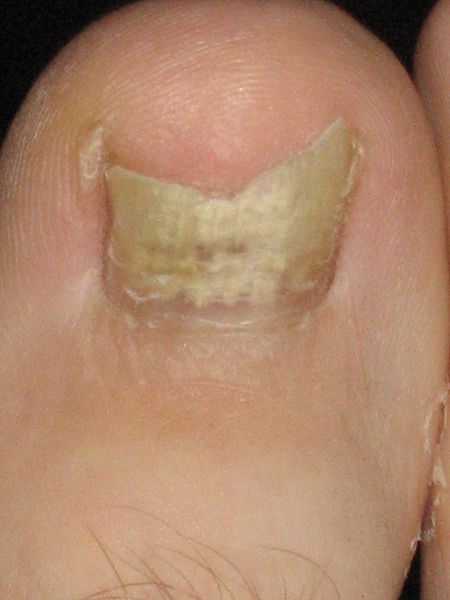 | |
|---|---|
| A toenail affected by Onychomycosis | |
| ICD-10 | B35.1 |
| ICD-9 | 110.1 |
| DiseasesDB | 13125 |
| MedlinePlus | 001330 |
| MeSH | D014009 |
|
WikiDoc Resources for Onychomycosis |
|
Articles |
|---|
|
Most recent articles on Onychomycosis Most cited articles on Onychomycosis |
|
Media |
|
Powerpoint slides on Onychomycosis |
|
Evidence Based Medicine |
|
Clinical Trials |
|
Ongoing Trials on Onychomycosis at Clinical Trials.gov Trial results on Onychomycosis Clinical Trials on Onychomycosis at Google
|
|
Guidelines / Policies / Govt |
|
US National Guidelines Clearinghouse on Onychomycosis NICE Guidance on Onychomycosis
|
|
Books |
|
News |
|
Commentary |
|
Definitions |
|
Patient Resources / Community |
|
Patient resources on Onychomycosis Discussion groups on Onychomycosis Patient Handouts on Onychomycosis Directions to Hospitals Treating Onychomycosis Risk calculators and risk factors for Onychomycosis
|
|
Healthcare Provider Resources |
|
Causes & Risk Factors for Onychomycosis |
|
Continuing Medical Education (CME) |
|
International |
|
|
|
Business |
|
Experimental / Informatics |
For patient information, click Onychomycosis
Editor-In-Chief: C. Michael Gibson, M.S., M.D. [3]; Associate Editor(s)-in-Chief: Kiran Singh, M.D. [4]
Synonyms and keywords: Tinea unguium; fungal nail infection
Overview
Onychomycosis means fungal infection of the nails. It represents up to 20% of all nail disorders.
This condition may affect toe- or fingernails, but toenail infections are particularly common. The most common type of onychomycosis (80-90%), caused by dermatophytes, is technically known as tinea unguium (tinea of the nails).[1] It can result in discoloration, thickening, chalkiness, or crumbling of the nails and is often treated by powerful oral medications which, rarely, can cause severe side effects including liver failure.
Classification
- Distal Subungual Onychomycosis
- The most common form of tinea unguium usually caused by Trichophyton rubrum, which invades the nail bed and the underside of the nail plate.
- White Superficial Onychomycosis
- Caused by fungal invasion of the superficial layers of the nail plate to form "white islands" on the plate. Accounts for only 10 percent of onychomycosis cases.
- Proximal Subungual Onychomycosis
- Fungal penetration of the newly formed nail plate through the proximal nail fold. It is the least common form of tinea unguium in healthy people but found more commonly when the patient is immunocompromised.
- Candidal Onychomycosis
- Candida species invade fingernails usually occurring in persons who frequently immerse their hands in water. This normally requires the prior damage of the nail by infection or trauma.
- Total Dystrophic Onychomycosis
- Total destruction of the nail plate. It is the end result of any of the above four types.
Causes
Dermatophytes are the fungi most commonly responsible for onychomycosis.
Two dermatophyte species, Trichophyton rubrum and Trichophyton interdigitale, cause the vast majority of onychomycosis cases worldwide.
Other related dermatophyte fungi that may be involved are Epidermophyton floccosum, Trichophyton violaceum, Microsporum gypseum, Trichophyton tonsurans, Trichophyton soudanense (considered by some to be an African variant of T. rubrum rather than a full-fledged separate species) and the cattle ringworm fungus Trichophyton verrucosum. A common outdated name that may still be reported by medical laboratories is Trichophyton mentagrophytes for T. interdigitale.
The name T. mentagrophytes is now restricted to the agent of favus skin infection of the mouse; though this fungus may be transmitted from mice and their danders to humans, it generally infects skin and not nails.
Other causal fungi include yeasts (5-17%), e.g., Candida, and non-dermatophytic moulds, in particular members of the mould genera Scytalidium (name recently changed to Neoscytalidium), Scopulariopsis, and Aspergillus.
Yeasts mainly cause fingernail onychomycosis in people whose hands are often submerged in water. Scytalidium mainly affects people in the tropics, though it persists if they later move to areas of temperate climate.
Other moulds mainly affect people over the age of 60, and their presence in the nail reflects a slight weakening in the nail's ability to defend itself against fungal invasion.
Epidemiology and Demographics
The prevalence of onychomycosis is about 6-8% in the adult population.[2]
Diagnosis
If all nails are affected then fungal infection is improbable. To avoid misdiagnosis as psoriasis, lichen planus, contact dermatitis, trauma, nail bed tumor or yellow nail syndrome, laboratory confirmation may be necessary. The three main approaches are potassium hydroxide smear, culture and histology. This involves microscopic examination and culture of nail scrapings or clippings. Recent results indicate that the most sensitive diagnostic approaches are direct smear combined with histological examination[3] and nail plate biopsy using periodic acid-Schiff stain[4].
Symptoms
The nail plate can have a thickened, yellow, or cloudy appearance. The nails can become rough and crumbly, or can separate from the nail bed. There is usually no pain or other bodily symptoms, unless the disease is severe. [5]
Dermatophytids are fungus-free skin lesions that sometimes form as a result of a fungus infection in another part of the body. This could take the form of a rash or itch in an area of the body that is not infected with the fungus. Dermatophytids can be thought of as an allergic reaction to the fungus.
Physical Examination
The following images show examples of how an onychomycosis patient's nails may look like. The nails may have a brown appearance.
(Images courtesy of Charlie Goldberg, M.D., UCSD School of Medicine and VA Medical Center, San Diego, CA)
-
Onychomycosis due to Trychophyton rubrum, right and left great toe.
-
Onychomycosis: Chronic fungal infection causing discoloration and deformity of nails.
-
Onychomycosis: Chronic fungal toenail infection causing deformity and discoloration.
Nails
-
Onychomycosis. With permission from Dermatology Atlas.[6]
-
Onychomycosis. With permission from Dermatology Atlas.[6]
-
Onychomycosis. With permission from Dermatology Atlas.[6]
-
Onychomycosis. With permission from Dermatology Atlas.[6]
Treatment
Treatment of onychomycosis is challenging because the infection is embedded within the nail and is difficult to reach. As a result full removal of symptoms is very slow and may take a year or more. Mild onychomycosis sometimes responds to a combination of topical antifungal medication, sometimes applied as special medicinal nail lacquer, and periodic filing of the nail surface. For advanced onychomycosis, especially if more than one nail is infected, systemic medication (pills) is preferred.
Pharmacotherapy
Most treatments are either systemic antifungal medications such as terbinafine and itraconazole, or topical such as nail paints containing ciclopirox or amorolfine. There is also evidence for combining systemic and topical treatments.[7]
For superficial white onychomycosis systemic rather than topical antifungal therapy is advised.[8]
Chronic Pharmacotherapies
Relative effectiveness of treatments
In July 2007 a meta-study reported on clinical trials for topical treatments of fungal nail infections. The study included 6 randomised controlled trials dating up to March 2005.[9] The main findings are:
- There is some evidence that ciclopiroxolamine and butenafine are both effective but both need to be applied daily for prolonged periods (at least 1 year).
- There is evidence that topical ciclopiroxolamine has poor cure rates and that amorolfine might be substantially more effective.
- Further research into the effectiveness of antifungal agents for nail infections is required.
A 2002 study compared the efficacy and safety of terbinafine in comparison with placebo, itraconazole and griseofulvin in treating fungal infections of the nails.[10] The main findings were that for reduced fungus terbinafine was found to be significantly better than itraconazole and griseofulvin, and terbinafine was better tolerated than itraconazole.
- A small study in 2004 showed that ciclopirox nail paint was more effective when combined with topical urea cream.[11]
- A study of 504 patients in 2007 found that aggressive debridement of the nail combined with oral terbinafine significantly reduced symptom frequency over terbinafine alone.[12]
- A 2007 randomised clinical trial with 249 patients show that a combination of amorolfine nail lacquer and oral terbinafine enhances clinical efficacy and is more cost-effective than terbinafine alone.[13]
Most drug development activities are focused on:
- the discovery of new antifungals
- novel delivery methods to promote access of existing antifungal drugs into the infected nail plate
Active clinical trials investigating Onychomycosis:[14]
Some phase III clinical trials revolving around onychomycosis are shown below.
- A medicinal nail lacquer, NM100060 from NexMed,[15] contains terbinafine as the active ingredient and a permeation enhancer which facilitates the delivery of the drug into the nail bed where the fungus resides. Commercial sale of the product is expected to begin no earlier than in 2010.[16]
- A comparison of delivery methods for Itraconzole.[17]
- Safety and tolerability of topical Terbinafine.[18]
Some phase II clinical trials revolving around onychomycosis are show below.
- A topical treatment, AN-2690, is being developed by Schering-Plough Corp and Anacor Pharmaceuticals. It is active against Trichophyton species.[19]
- Posaconazole, taken orally.[20]
- A topical treatment, NB-002, is being developed by NanoBio Corporation.[21] It has completed Phase II trails.[22]
A non-pharmalogical approach with encouraging preliminary results is ultraviolet germicidal irradiation which has been shown to deactivate dermatophytes both in vitro and ex vivo.[23]
Natural remedies As with many diseases, there are also some scientifically unverified folk or alternative medicine remedies.
- Australian tea tree oil.[24][25] In a study at the University of Rochester tea tree oil applied twice daily in conjunction with debridement was found to be an appropriate initial treatment strategy, equally effective to topical use of clotrimazole[26].
- Grapefruit seed extract as a natural antimicrobial is not demonstrated. Its effectiveness is scientifically unverified. Multiple studies indicate that the universal antimicrobial activity is due to contamination with synthetic preservatives that were unlikely to be made from the seeds of the grapefruit.[27][28][29][30][31]
- Another procedure is to apply two drops of distilled white vinegar to the nail base, or, additionally, nail plate and under the nail, two or three times daily for approximately six months or until the fungus is gone. This treatment is very effective, due to the vinegar's acidity, if followed consistently.
New developments
- A medicinal nail lacquer, NM100060 from NexMed is in Phase III clinical trials[32]. It contains terbinafine as the active ingredient and a permeation enhancer which facilitates the delivery of the drug into the nail bed where the fungus resides. Commercial sale of the product is expected to begin no earlier than in 2008. [33]
- A topical treatment, AN-2690, is being developed by Schering-Plough Corp. It is active against Trichophyton species. Phase II and IIb trials are underway. [19]
Active clinical trials investigating Onychomycosis: [5].
Primary Prevention
- Avoid walking barefoot in public areas such as showers, communal changing rooms.
- Keeping feet clean and dry.
- Avoid sharing shoes and socks
Antimicrobial Regimen
- Onychomycosis
- Fingernail Treatment Options
- Preferred regimen: Terbinafine 250 mg PO q24h (children <20 kg: 67.5 mg/day, 20–40 kg: 125 mg/day, >40 kg: 250 mg/day) for 6 weeks OR Itraconazole 200 mg PO q24h for 3 months OR Itraconazole 200 mg PO bid for 1 week/month for 2 months OR Fluconazole 150–300 mg PO q week for 3–6 months
- Toenail Treatment Options
- Preferred regimen: Terbinafine 250 mg PO q24h (children <20 kg: 67.5 mg/day, 20–40 kg:125 mg/day, >40 kg: 250 mg/day) for 12 weeks OR Itraconazole 200 mg PO q24h for 3 months OR Itraconazole 200 mg bid for 1 week/month for 3–4 months OR Fluconazole 150–300 mg PO q week for 6–12 months
References
- ↑ Perea S, Ramos MJ, Garau M, Gonzalez A, Noriega AR, del Palacio A (2000). "Prevalence and risk factors of tinea unguium and tinea pedis in the general population in Spain". J. Clin. Microbiol. 38 (9): 3226–30. PMID 10970362.
- ↑ "Impact 07 - Dermatology" (PDF). Bay Bio. 2007. Retrieved 2007-06-13.
- ↑ PMID 17222296
- ↑ PMID 12894064
- ↑ http://www.emedicine.com/derm/topic300.htm
- ↑ 6.0 6.1 6.2 6.3 "Dermatology Atlas".
- ↑ Rodgers P, Bassler M (2001). "Treating onychomycosis". Am Fam Physician. 63 (4): 663–72, 677–8. PMID 11237081.
- ↑ Baran R, Faergemann J, Hay RJ (2007). "Superficial white onychomycosis--a syndrome with different fungal causes and paths of infection". J. Am. Acad. Dermatol. 57 (5): 879–82. doi:10.1016/j.jaad.2007.05.026. PMID 17610995.
- ↑ Crawford F, Hollis S (2007). "Topical treatments for fungal infections of the skin and nails of the foot". Cochrane Database Syst Rev (3): CD001434. doi:10.1002/14651858.CD001434.pub2. PMID 17636672.
- ↑ Haugh M, Helou S, Boissel JP, Cribier BJ (2002). "Terbinafine in fungal infections of the nails: a meta-analysis of randomized clinical trials". Br. J. Dermatol. 147 (1): 118–21. PMID 12100193.
- ↑ Mitchel L. Zoler (April 1, 2004). "Boosts drug entry into nails: urea, ciclopirox combo tested for onychomycosis.(Focus on Skin Disorders)". Internal Medical News. p. 69.
- ↑ Potter LP, Mathias SD, Raut M, Kianifard F, Landsman A, Tavakkol A (2007). "The impact of aggressive debridement used as an adjunct therapy with terbinafine on perceptions of patients undergoing treatment for toenail onychomycosis". The Journal of dermatological treatment. 18 (1): 46–52. PMID 17373090.
- ↑ Baran R, Sigurgeirsson B, Berker DD; et al. (2007). "A multicentre, randomized, controlled study of the efficacy, safety and cost-effectiveness of a combination therapy with amorolfine nail lacquer and oral terbinafine compared with oral terbinafine alone for the treatment of onychomycosis with matrix involvement". British Journal of Dermatology. 157: 149. doi:10.1111/j.1365-2133.2007.07974.x. PMID 17553051.
- ↑ clinicaltrials.gov
- ↑ Clinical trial number NCT00459537 at ClinicalTrials.gov
- ↑ NEXMED Medicines of the Future
- ↑ Clinical trial number NCT00356915 at ClinicalTrials.gov
- ↑ Clinical trial number NCT00443820 at ClinicalTrials.gov and Clinical trial number NCT00443898 at ClinicalTrials.gov
- ↑ 19.0 19.1 Barak O, Loo DS (2007). "AN-2690, a novel antifungal for the topical treatment of onychomycosis". Curr Opin Investig Drugs. 8 (8): 662–8. PMID 17668368.
- ↑ Clinical trial number NCT00491764 at ClinicalTrials.gov
- ↑ Clinical trial number NCT00356915 at ClinicalTrials.gov
- ↑ NanoBio - Onychomycosis
- ↑ PMID 18410410
- ↑ Buck DS, Nidorf DM, Addino JG (1994). "Comparison of two topical preparations for the treatment of onychomycosis: Melaleuca alternifolia (tea tree) oil and clotrimazole". J Fam Pract. 38 (6): 601–5. PMID 8195735.
- ↑ Nenoff P, Haustein UF, Brandt W (1996). "Antifungal activity of the essential oil of Melaleuca alternifolia (tea tree oil) against pathogenic fungi in vitro". Skin Pharmacol. 9 (6): 388–94. PMID 9055360.
- ↑ [1].
- ↑ von Woedtke T, Schlüter B, Pflegel P, Lindequist U, Jülich WD (1999). "Aspects of the antimicrobial efficacy of grapefruit seed extract and its relation to preservative substances contained". Pharmazie. 54 (6): 452–6. PMID 10399191.
- ↑ Sakamoto S, Sato K, Maitani T, Yamada T (1996). "[Analysis of components in natural food additive "grapefruit seed extract" by HPLC and LC/MS]". Eisei Shikenjo hōkoku. Bulletin of National Institute of Hygienic Sciences (in Japanese) (114): 38–42. PMID 9037863.
- ↑ Takeoka G, Dao L, Wong RY, Lundin R, Mahoney N (2001). "Identification of benzethonium chloride in commercial grapefruit seed extracts". J. Agric. Food Chem. 49 (7): 3316–20. PMID 11453769.
- ↑ Takeoka GR, Dao LT, Wong RY, Harden LA (2005). "Identification of benzalkonium chloride in commercial grapefruit seed extracts". J. Agric. Food Chem. 53 (19): 7630–6. doi:10.1021/jf0514064. PMID 16159196.
- ↑ Ganzera M, Aberham A, Stuppner H (2006). "Development and validation of an HPLC/UV/MS method for simultaneous determination of 18 preservatives in grapefruit seed extract". J. Agric. Food Chem. 54 (11): 3768–72. doi:10.1021/jf060543d. PMID 16719494.
- ↑ Clinical trial number NCT00459537 at ClinicalTrials.gov
- ↑ [2]
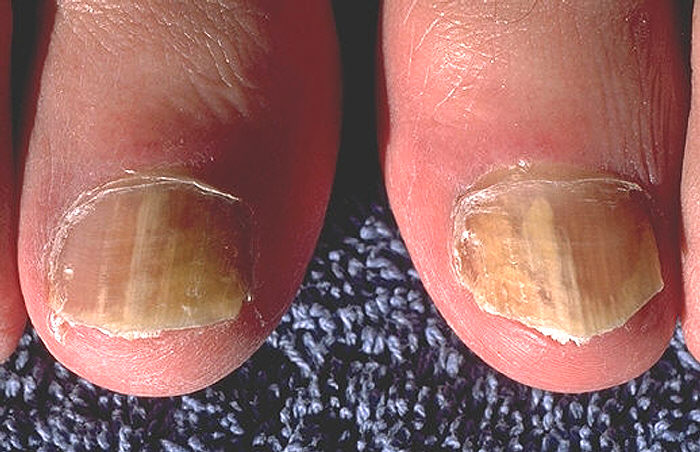
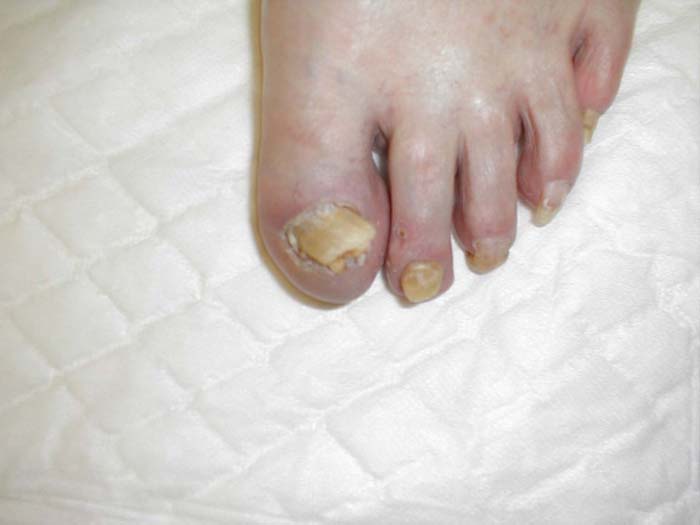
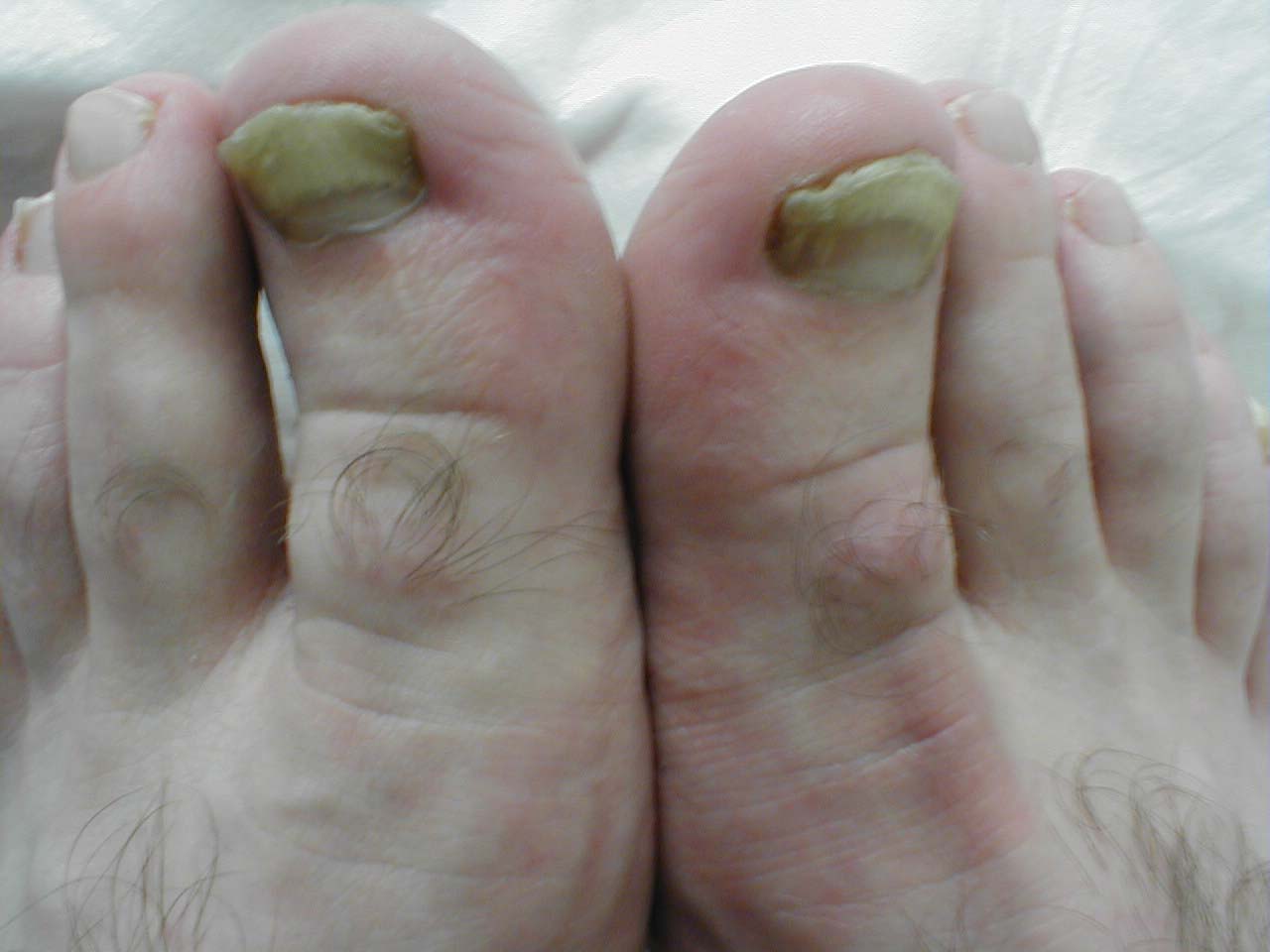
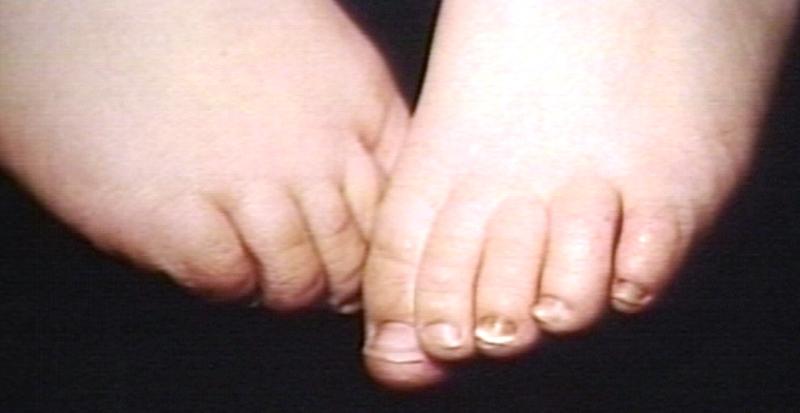
![Onychomycosis. With permission from Dermatology Atlas.[6]](/images/c/ca/Onychomycosis01.jpg)
![Onychomycosis. With permission from Dermatology Atlas.[6]](/images/5/58/Onychomycosis02.jpg)
![Onychomycosis. With permission from Dermatology Atlas.[6]](/images/0/05/Onychomycosis03.jpg)
![Onychomycosis. With permission from Dermatology Atlas.[6]](/images/1/1e/Onychomycosis04.jpg)